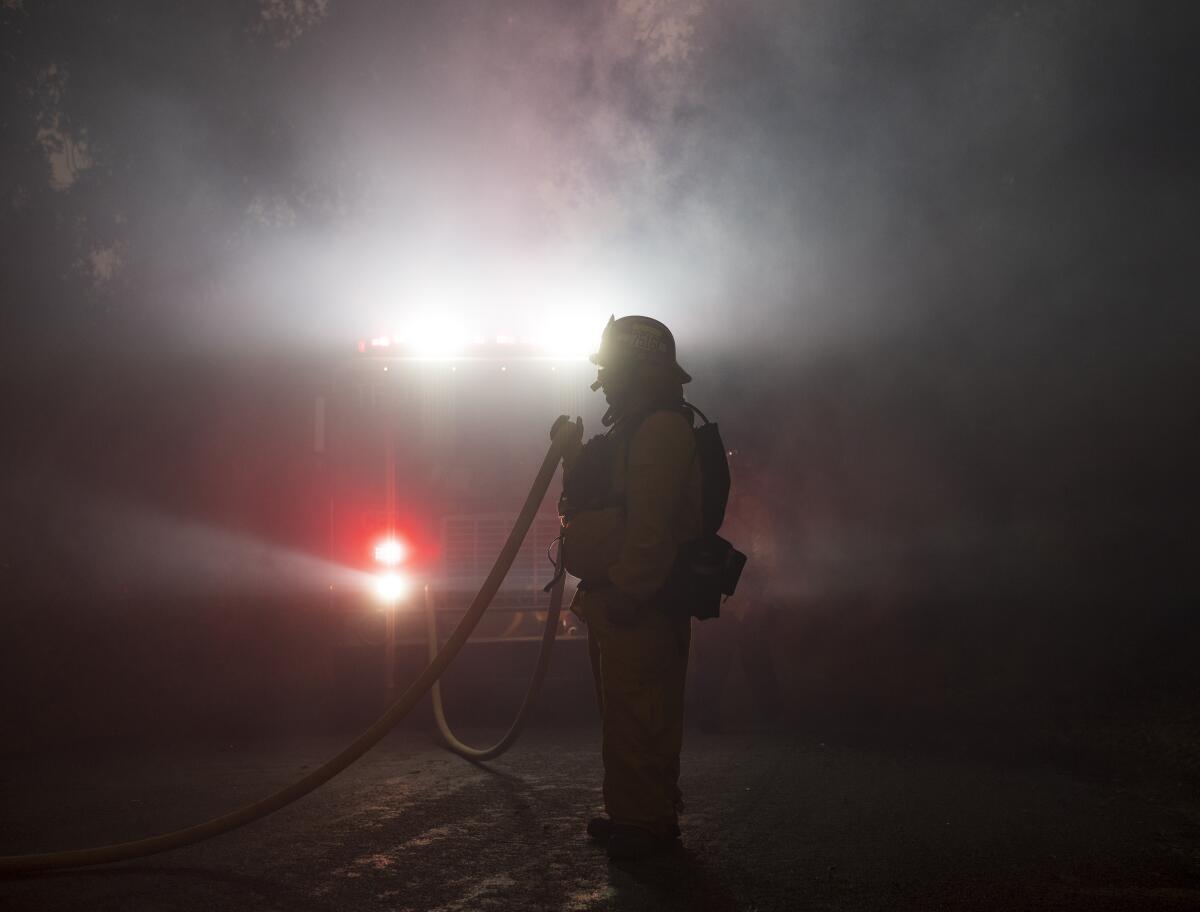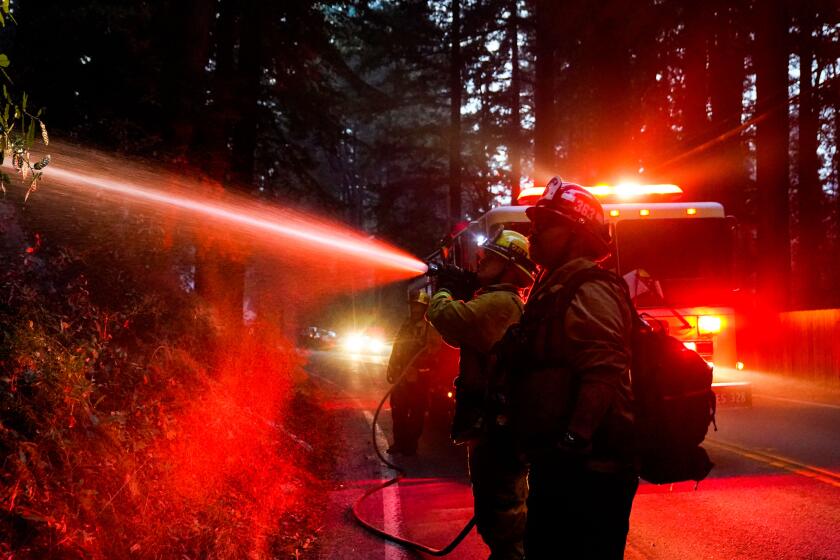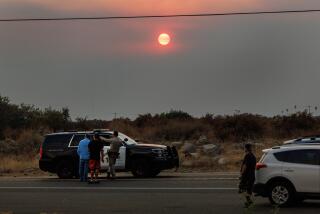Smoke from wildfires chokes Bay Area as ozone smog threatens Southern California

MENLO PARK — As fires burn throughout eight of the nine counties in the San Francisco Bay Area, the region is being blanketed by smoke and ash, creating dangerous breathing conditions in a time of pandemic, when healthy lungs matter more than ever.
The smoke comes as the typically cool and dry Bay Area roasts under a prolonged, record-breaking heat wave, forcing residents without air conditioning either to swelter in their homes or venture to public cooling centers. More than 22,000 people have been ordered to evacuate in and around the Santa Cruz Mountains.
Erin DeMerritt, spokeswoman for the Bay Area Air Quality Management District, said people should seek public cooling centers if their homes became too hot, even if it means being exposed to the wildfire smoke. “Heat takes precedence,” she said.
She said the poor air quality resulting from the smoke would probably continue until the fires were mostly contained. A Cal Fire status report on the LNU Lightning Complex fire on Wednesday suggests conditions may not improve until Sept. 1.
She also noted that although most cloth masks, including bandannas, help protect against the spread of COVID-19, they do not protect against particulate matter from the smoke.
The American Lung Assn. urged Northern Californians to be careful Wednesday, warning that the combination of excessive heat, wildfire smoke and COVID-19 poses risks to those most vulnerable to respiratory problems.
“The combination of uncontained wildfires and extreme heat has created conditions that put even healthy individuals at risk,” said Afif El-Hasan, an association spokesman. “The ongoing COVID-19 pandemic only makes these potential effects more serious.”
Intense smoke and heat trigger coughing and wheezing, worsen lung function and lead to bronchitis or even death, he said.
“The best thing you can do is to avoid outdoor air,” San Francisco Mayor London Breed said. Ash could be seen falling across the region.
Everyone should avoid outdoor exercise when smoke is in the air. “Wildfire smoke is especially harmful,” said Mat Ehrhardt, air pollution control officer for the Yolo-Solano Air Quality Management District, adding that particulate matter about one-thirtieth the width of a human hair can penetrate deep into the lungs.
Northern California’s coastal areas generally have some of the state’s cleanest air, thanks to offshore breezes. But on Tuesday evening, fires burned throughout the Bay Area — from Point Reyes in the north, to Monterey and Big Sur in the south — and towns such as Bonny Doon were experiencing severely polluted air. Smoke drifted down into the Bay Area, settling thickest atop the cities of the San Francisco peninsula, including Mountain View, Palo Alto and Burlingame.
DeMerritt said southward winds were blowing the Marin fire smoke into south San Francisco all the way down to San Jose, while winds along the coast were bringing in smoke from the Lightning Complex fire in the Santa Cruz Mountains, as well as the River and Carmel fires in Monterey County.
On Wednesday morning, cars that had been parked outside along the peninsula were covered in ash and dust, as were windows and outdoor furniture. The air was visibly hazy, and the smell of campfire was sharp.
Air Quality Index readings ranged from the mid-100 levels along the San Francisco Bay to 413 in Redwood City’s hills, according to the website PurpleAir.
The Air Quality Index is the yardstick the Environmental Protection Agency uses for reporting air quality. Levels ranging from 151 to 200 are considered unhealthy; from 201 to 300, very unhealthy; and 301 and above, hazardous.
In and around Los Angeles, the South Coast Air Quality Management District continued an advisory for ozone pollution, stating that “extremely high temperatures are expected to persist over the next several days ... increasing the likelihood of Unhealthy to Very Unhealthy air quality in many areas.”
But problems with wildfire smoke in the region have diminished markedly in recent days, partly because of the near-containment of the massive Apple fire in the San Bernardino National Forest.
By contrast, the city of Hillsborough, just south of San Francisco, had the nation’s worst air quality Wednesday morning, according to IQAir.
The LNU Lightning Complex fire has burned more than 124,000 acres in Napa, Sonoma, Solano, Yolo and Lake counties. Evacuations have been ordered in western Vacaville.
Northern and Central California began experiencing an unusually active sequence of largely dry lightning strikes Sunday morning, the most widespread and violent in recent memory in the Bay Area on one of the hottest nights in years, according to Daniel Swain, a climate scientist with UCLA and the National Center for Atmospheric Research.
Solano County was facing serious threat Wednesday morning after fire caused residents to flee overnight and burned homes and other structures.
Officials have ordered the evacuation of the western edge of Vacaville — a city of 100,000 residents about halfway between San Francisco and Sacramento — in the area of Alamo Drive north of Interstate 5 and west of North Orchard Avenue, according to a Facebook post by Vacaville police. The Vacaville Fire District also ordered evacuations of Pleasants Valley Road, which lies west of the city, and the English Hills area north of the city.
Smoke and ash were also a problem far to the east of the Bay Area, especially downwind of a fire near Nevada City, northeast of Sacramento, and in areas downwind of the Solano fires. On Wednesday morning, ash swirled in the air in Sacramento. Thick smoke cast a haze and left many wearing their pandemic masks outside to fend off the pollution.
Staff writers Joseph Serna, Anita Chabria, Rong-Gong Lin II , Luke Money, Leila Miller and Colleen Shalby contributed to this report.
More to Read
Sign up for Essential California
The most important California stories and recommendations in your inbox every morning.
You may occasionally receive promotional content from the Los Angeles Times.












